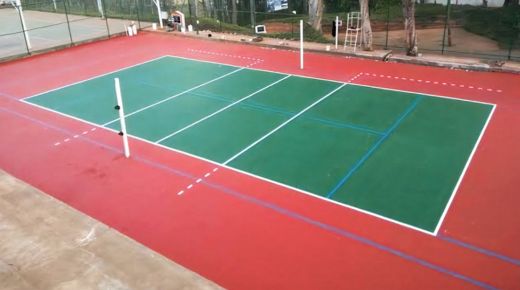Volleyball is a dynamic and fast-paced sport that requires not only skill and agility but also the right playing surface to ensure safety and enhance performance. Whether you’re designing an indoor facility or an outdoor court, selecting the appropriate volleyball court material and choosing the perfect volleyball court colors are crucial decisions that can significantly impact gameplay and player experience.
In this guest post, we’ll explore the importance of using high-quality materials and strategic color choices to create a volleyball court that not only looks great but also delivers optimal performance.
Selecting the Right Volleyball Court Material
When constructing a volleyball court, the surface material plays a pivotal role in player safety, ball behavior, and long-term durability. Two primary types of courts exist—indoor courts and outdoor courts—each with distinct material requirements.
1. Indoor Volleyball Court Materials
Indoor volleyball courts are typically made from hardwood, synthetic flooring, or acrylic. Each material offers specific benefits:
- Hardwood Flooring: Traditionally used for professional indoor courts, hardwood provides a natural, high-quality playing surface. It offers good ball bounce and traction, but it requires regular maintenance.
- Synthetic Flooring: For sports facilities that want a more cost-effective and low-maintenance option, synthetic flooring is an excellent choice. It mimics the properties of hardwood while offering shock absorption, reducing the risk of injuries.
- Acrylic Flooring: Known for its durability, acrylic flooring is a great choice for multipurpose sports facilities. It’s highly resistant to wear and tear, making it ideal for both recreational and professional volleyball matches.
2. Outdoor Volleyball Court Materials
Outdoor volleyball courts require materials that can withstand harsh weather conditions while still providing a safe and playable surface. Some popular materials include:
- Acrylic Surfacing: Acrylic flooring is also a go-to material for outdoor courts. It provides excellent weather resistance, slip control, and UV protection, ensuring a long-lasting and vibrant playing surface.
- Sand or Grass: Often used for beach volleyball, sand provides a softer surface that helps prevent injuries. Grass courts, although less common, offer a natural environment and can be an affordable option for recreational games.
At Pacecourt, we specialize in providing top-of-the-line acrylic sports flooring for both indoor and outdoor volleyball courts. Our materials are designed to offer superior performance, longevity, and safety for all levels of play.
The Impact of Volleyball Court Colors on Gameplay and Aesthetics
Choosing the right volleyball court colors is more than just about aesthetics. The right color combination can influence gameplay, enhance visibility, and create an inviting atmosphere for players and spectators alike.
1. Enhancing Visibility
Visibility is one of the most important factors to consider when selecting court colors. Bright, contrasting colors help players easily identify court boundaries, the net, and the ball during fast-paced action. Common color schemes include:
- Blue and White: Blue is a popular choice for volleyball courts because it provides a strong contrast against a white volleyball, making it easier for players to track the ball mid-air.
- Green and Yellow: These colors are often used in outdoor courts, particularly in grass or sand-based environments, as they offer a natural yet vibrant look that stands out.
- Red and Black: For indoor facilities, red and black can create a striking and modern aesthetic. These colors can be used for lines or accent areas to improve court boundary visibility.
2. Boosting Player Focus
Colors can also affect player focus and mental clarity. Soft, cool tones like light blue and green are known to have a calming effect, helping players concentrate during long, intense matches. On the other hand, bold, warm colors like red and orange can evoke excitement and energy, which may enhance player motivation and engagement.
3. Enhancing Aesthetics and Branding
Court colors can be tailored to reflect your facility’s branding or community identity. Customizing the volleyball court colors with your facility’s logo, team colors, or specific design elements creates a unique and professional look.
At Pacecourt, we offer a wide range of customizable color options to suit your facility’s needs. Our acrylic surfacing comes in vibrant, long-lasting hues that maintain their brightness, even after years of exposure to sunlight and heavy foot traffic.
Conclusion: Building the Ideal Volleyball Court with Pacecourt
Creating the perfect volleyball court involves careful consideration of both volleyball court material and volleyball court colors. Choosing the right material ensures durability, player safety, and optimal performance, while the right colors can enhance visibility, improve focus, and elevate the overall look of your facility.
At Pacecourt, we are committed to providing world-class volleyball court solutions tailored to your specific needs. Whether you’re looking for high-quality acrylic flooring or custom color schemes, our team of experts is here to help you design a court that meets both professional and recreational standards.


